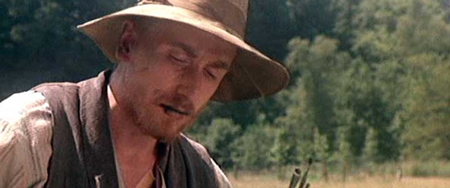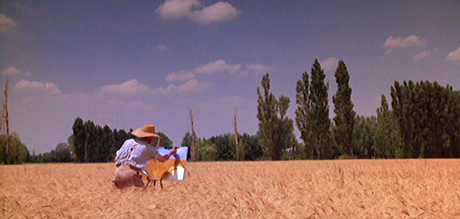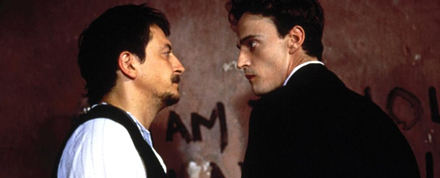Reviewed by Glenn Erickson
Here's something special -- a modestly budgeted revisit of a subject already 'covered' by a name director. Just a few minutes in, we're no longer comparing this version to the Oscar-winning superproduction from 34 years before.

In terms of bankability, Robert Altman's career in 1990 was at low ebb. It was still a couple of years before his bounce-back hit The Player. Yet Altman continued to turn out interesting alternatives to big-studio output. Vincent & Theo is a particularly worthwhile project, filmed in France and Holland and directed as if in pursuit of the same kind of artistic muse that Vincent Van Gogh was after. The film helped bring Tim Roth to international attention as well.
It's the late 1880s in France. Art salesman Theo Van Gogh (Paul Rhys) turns thirty. He remains frustrated in his work, but happily subsidizes his older brother Vincent (Tim Roth), who has decided to become an artist. As he works out his compulsion to paint, the already unstable Vincent is dogged by inner demons. He sells nothing, even with Theo trying his best. Vincent relocates to the South of France with artist Paul Gauguin (Wladimir Yordanoff). The intensity of his paintings increases as he becomes less balanced. Theo puts Vincent under the care of a good doctor (Jean-Pierre Cassel), who thinks the painter is only going to become more insane.
As far as Hollywood is concerned the Vincent Van Gogh story began and ended with Vincente Minnelli's 1956 Lust for Life, in which Kirk Douglas plays the artist as a frantic, frustrated powerhouse. Like Cody Jarrett in White Heat, Douglas's Vincent seems ready to explode. Minnelli balanced that quality by drenching the screen with close-ups of paintings and blasting the viewer with rhapsodic Miklos Rozsa music. In that film, Vincent's brother Theo is a calming influence, a sane man trying to help a lost soul.

Working in different times with a different sensibility, Altman isn't interested in an art appreciation movie with bombastic theatrics. He instead illuminates screenwriter Julian Mitchell's portrait of the artist as a grungy outcast rejected by his world and barely tolerated by those he loves. Vincent is a selfish, egotistical and a hygienic disaster, but his commitment to his painting is total. Kirk Douglas did his best to appear to be the man who could create such startling canvasses, whereas Tim Roth quietly inhabits a tortured fellow expending all of his energy in one direction. Suffering from depression and clearly not helped by bouts of mental anguish, this Van Gogh creates as if it were a symptom of a disease.
Screenwriter Mitchell brings Vincent's brother Theo back into the picture, and his adventures in Paris (seen almost exclusively in interiors) show an equally sensitive fellow. Theo's mental balance is better, yet he is losing a battle with ill health brought on by syphilis. Paul Rhys' Theo quietly plays the game to get ahead in the business world of art
 galleries, but remains an employee on commission. We see how little things have changed in the 130 years or so that have passed. The buyers go for trends ("What -ism is this now?") and have no eye for the truly new or different. The bold and smooth-talking Paul Gauguin isn't selling particularly well, as his name hasn't yet been established. The very different work by Vincent is mostly ignored. The fact that his brother Theo is his only salesman is probably a detriment.
galleries, but remains an employee on commission. We see how little things have changed in the 130 years or so that have passed. The buyers go for trends ("What -ism is this now?") and have no eye for the truly new or different. The bold and smooth-talking Paul Gauguin isn't selling particularly well, as his name hasn't yet been established. The very different work by Vincent is mostly ignored. The fact that his brother Theo is his only salesman is probably a detriment.
Altman gets heavily into the bohemian lifestyle. Theo has his wild times but wants to settle down with his best friend's sister from Holland; she's willing to commit to him even with his STD problem. Vincent is by contrast the kind of unsightly vagrant soul that can't be taken anywhere. Gentleman artists reject him for associating with prostitutes, with whom he sometimes shares his appallingly dingy room. The film stresses Van Gogh as a messy, disorganized man. He absently smears himself with paint and frequently gets it into his teeth, which are already a disgraceful display of caries. Altman and Roth express the notion that Vincent wants to become one with his oils. The painter cheerfully dips his fingers into the colors in an artist's store and smears paint on himself when he tries to face down his madness in a mirror. Clearly insane over the very concept of color, Vincent paints the face of a prostitute. He ends up transformed into a crimson statue, soaked with his own blood.

Theo has his own problems with impending mortality and as such functions as Vincent's straight-world twin. Perhaps grudgingly at first, he nevertheless supports Vincent and his work throughout the artist's brief career, as if trying to keep alive the creative part of his own soul. Theo is a prisoner of commerce and in some ways envies his brother's purity of purpose.
This subject must have struck a chord with Robert Altman, for he seems charged with making a specific statement instead of setting in motion another of his big-cast pageants to simply observe with his cameras. His direction displays a keen interest in the creative process, almost from an autobiographical point of view. The camera retains its respect for the painter even when it shows his gaping flaws. It's easy to draw a parallel between Van Gogh and Altman the filmmaker who continued on his own course after Hollywood slammed the door on him in the late 1970s. Altman understands artistic compulsion, and knows that no one need make excuses for it.

Tim Roth is appropriately intense as he rides his waves of manic depression; when it's apparent that Vincent is losing his grip on himself he doesn't ask for anybody's sympathy. Paul Rhys' Theo is wracked with self-doubt but helped by outside encouragement and the love of a good woman. Even his employers are better than they might be. Amusingly, Theo's wife is not a flighty Paris girl but a good homegrown lass. Theo strives for a stability he knows his body will never allow him.
The movie begins with a brilliant stroke perhaps inspired by Sergio Leone's Once Upon a Time In America: a video shot of a Van Gogh masterpiece being bid up to 22 million dollars cuts to the miserable Van Gogh arguing with his brother. Theo blanches at the idea that Vincent wants to start painting, while the audio of an auction over a hundred years later continues to be heard on the soundtrack. It's a great and indirect way to remind the audience that Van Gogh never sold a painting in his lifetime. 1

Olive Films' Blu-ray of Vincent & Theo looks very rich in HD, with rich, dark interiors and sunny exteriors, all in bright color. Altman makes an effort to avoid the fussy 'standard of quality' of the Minnelli classic and comes up with a viable alternate take on the famous painter. The contrast is seen right up front. The sloppy main title card with its lettering barely on the screen seems a protest against the MGM film's carefully designed graphics. Technically, the film's on-screen title appears to be just "Vincent Theo." Of special mention is Gabriel Yared's wrenching, discordant music score, which underscores the leading characters' instability.
A trailer is included, but nothing more. The original MGM DVD had a very good featurette-docu that presented Altman and his son, production designer Stephen Altman, talking about their production. French art students were hired to create the many fake Van Gogh works in progress and seen hanging in Theo's private gallery. On the missing docu, Altman explained that the project started as a miniseries with the BBC, but when it was decided to go for a film release, he had to set aside two hours of 'back story' material, which never saw the light of day.

On a scale of Excellent, Good, Fair, and Poor,
Vincent & Theo Blu-ray rates:
Movie: Excellent
Video: Very Good
Sound: Very Good
Supplements: Trailer
Deaf and Hearing Impaired Friendly?
No; Subtitles: None
Packaging: Keep case
Reviewed: June 8, 2015
Footnote:
1. Hi Glenn, Enjoyed your review of Altman's film, which I remember liking when it came out. Tim Roth, however, failed to replace Kirk as a Van Gogh equivalent. Turns out, Vincent did sell just one painting while still alive in 1890, The Red Vineyard from 1888, to a Belgian painter, Anna Boch. Excuse my mentioning this if you've already been inundated with e-mails concerning it. Regards, Gordon
Return

Text © Copyright 2015 Glenn Erickson
See more exclusive reviews on the Savant Main Page.
Reviews on the Savant main site have additional credits information and are often updated and annotated with footnotes, reader input and graphics.
Return to Top of Page
|


